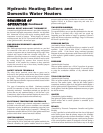
Installation and
Service Manual
55
4. The temperature set points for all stages should be set at
the same temperature when supplying potable hot water
for domestic use.
5. Stage firing is achieved by setting the differentials at
approximately 3°F, 5°F, 7°F and 9°F for stages 1, 2, 3, and
4. Stage firing of a potable water heater should only be
used to replace system standby heat loss.
6. All stages of burner operation should fire when there is a
major draw from the potable hot water storage system.
This prevents possible condensate problems and ensures a
rapid recovery of the hot water used.
Note: This water heater, when set at a lower temperature
setting, is not capable of producing hot water of sufficient
temperature for sanitizing purposes.
Location of Cold Water Supply Piping
Connections
Incorrect piping of the cold water supply to the system may result
in excessive low temperature operation causing condensate
formation on the heat exchanger and operational problems. You
must install the cold water supply piping in the discharge piping
from the heater to the storage tank. This allows the cold water to
be tempered in the storage tank before entering the heater. See
FIG. 54 and typical installation drawings provided with the unit
for correct piping. Higher water temperatures reduce condensate
formation.
High Water Temperature Limit Control
The unit is equipped with an adjustable setting, manual-reset high
water temperature limit control. The hot water heater temperature
limit control has a maximum limit setting of 200°F (93°C). If
water temperature exceeds the set point, the limit will break the
control circuit and shut down the unit. The limit control will only
be reset after the water temperature has cooled below the set
point of the limit. The high water temperature limit control is
mounted in the outlet side of the front header.
Optional Relief Valve
This water heater is normally supplied with a temperature and
pressure relief valve(s) sized in accordance with applicable
codes. Units may be supplied with an optional pressure only
relief valve(s). When a water heater equipped with this optional
relief valve is piped to a separate storage vessel, the storage
vessel must have a properly installed temperature and pressure
relief valve which complies with local codes.
Thermal Expansion
A relief valve which discharges periodically may be due to
thermal expansion in a closed system. A hot water supply boiler
installed in a closed system, such as one with a backflow
preventer or check valve installed in the cold water supply, shall
be provided with means to control expansion. Contact the water
supplier or local plumbing inspector on how to correct this
situation. Do not plug or cap the relief valve discharge!
Cathodic Protection
Hydrogen gas, which is extremely flammable, can be produced
in a hot water system that has been unused for a long period of
time (generally two weeks or more). To prevent the possibility of
injury under these conditions, open the kitchen sink hot water
faucet for several minutes before using any electrical appliance
connected to the hot water system. If hydrogen is present, there
will be an unusual sound such as air escaping through the pipe
as the hot water begins to flow. Do not smoke or have open
flames near the faucet at this time.
• Water temperature over 125°F (52°C)
can cause severe burns instantly or
death from scalds.
• Children, disabled and elderly are
at highest risk of being scalded.
• See instruction manual before
setting temperature at heating
appliance.
• Feel water before bathing or showering.
• If this appliance is used to produce
water that could scald if too hot,
such as domestic hot water use,
adjust the outlet control (limit) or use
temperature limiting valves to obtain
a maximum water temperature of
125°F (52°C).
ƽ WARNING: Return water temperatures
must not be less than 140°F (60°C). If lower
return water temperatures are required, follow
the instructions for Low Temperature Return
Water Systems, page 36.
IMPORTANT: When water is stored at
temperatures above 125°F (52°C), a thermostatic
mixing valve must be installed on the hot water
outlet from the storage tank to supply lower
temperature water and prevent the risk of a scald
injury.


















